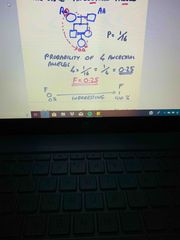![]()
![]()
![]()
Use LEFT and RIGHT arrow keys to navigate between flashcards;
Use UP and DOWN arrow keys to flip the card;
H to show hint;
A reads text to speech;
16 Cards in this Set
- Front
- Back
|
Problems in conservation genetics |
1) Small populations • E.g. Javan Rhino, 40-60 individuals - Genetic instability 2) Survival in managed populations • e.g. Siberian Tigers- 300 wild, 200 captivity 3) Conservation of breeds • Inbreeding - Small populations - “inbreeding depression” Reduction in reproductive fitness Reduction in survivability |
|
|
Inbreeding depression |

Back (Definition) |
|
|
What is happening during inbreeding depression |

Extreme case- Selfing population |
|
|
Inbreeding vs hybrid vigour |
Increase in frequency of deleterious mutations • e.g. Siberian Tiger (China) 1980s 8 original tigers now 200 tigers - Physical degradation - Striped patterns blurred - Downs Syndrome |
|
|
What happens with rare alleles? |

Deleterious alleles |
|
|
Inbreeding |

Back (Definition) |
|
|
How do we measure inbreeding |

Coefficient of inbreeding Probability of two alleles of a given gene being identical because they descend from the same ancestral allele |
|
|
Effect of a high inbreeding coefficient |

Back (Definition) |
|
|
Population size |
Effective population size Ne - takes into account age & sex distribution |
|
|
Population size (2) |
Back (Definition) |
|
|
Inbreeding |
- Inbreeding coefficient - How is it changing? - When will it become too high? |
|
|
Conservation of population |
1) Unmanaged populations - Random breeding 2) Managed populations - 200s, wildlife parks 3) Wild Animals |
|
|
Unmanaged populations |
E.g. Horse breed- Native to Portugal- Sorraia Nearly extinct- 1937, 5 Males & 7 females - conservation - 2001, 160 animal recorded • Genetic bottleneck • Current animals derived from 2 females |
|
|
Managed breeding |
- 200s, Parks - Pedigree - Choose mates that maximise outbreeding - Studbook |
|
|
Wild animals |
Back (Definition) |
|
|
How do we measure genetic variability |
1) Pedigrees 2) Genetic testing- DNA fingerprinting Family of genes - Microsatellites • Measure heterozygosity - Inbreeding |

